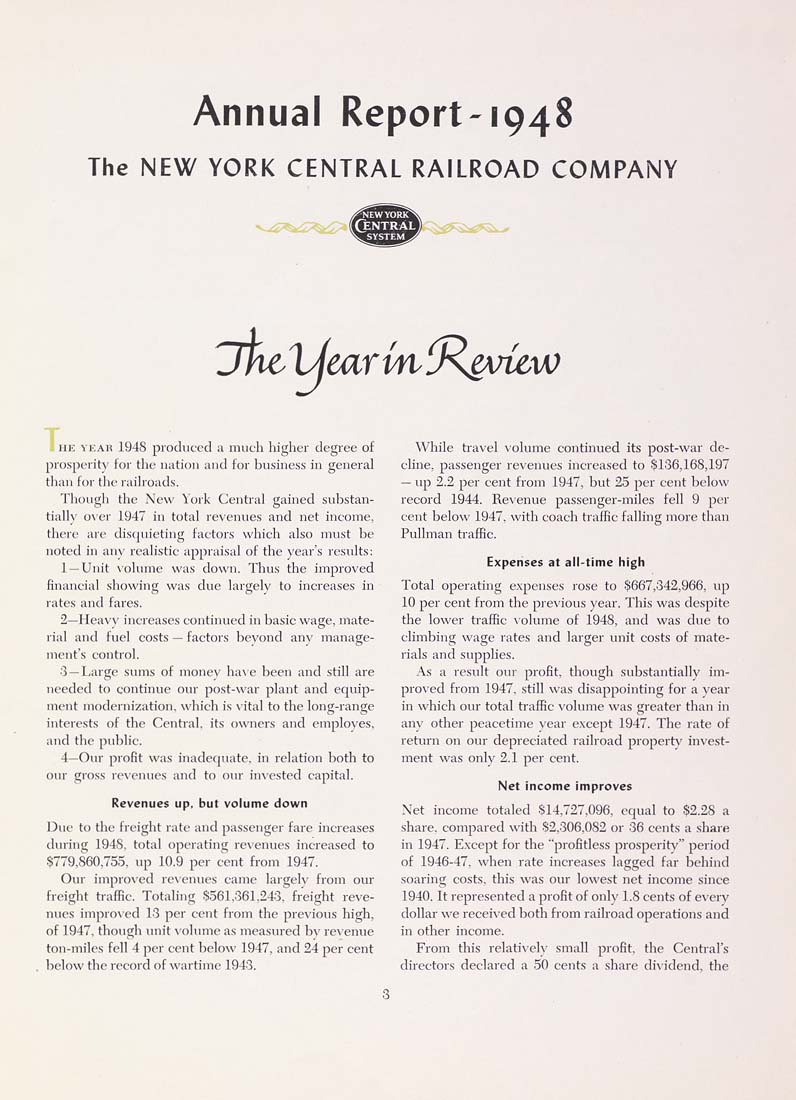Annual Report-1948
The NEW YORK CENTRAL RAILROAD COMPANY
v.^£^i?^£>(!
ZfhcVfearm!K^mcw
I HE VKAH 1948 prodiict'd a much higher degree of
pro.spcritv for the niitioTi and for bii.siness in general
than for tlic i-aiIroads.
Though the New York Central gained substan¬
tially over 1947 in total revenues and net income,
there are disquieting factors which also must be
noted in any realistic appraisal of the year's results:
1 —Unit volume was down. Thus the improved
finaneial showing was due largely to increases in
rates and fares.
2—Heavy increases continued in basic wage, mate¬
rial and fuel costs — factors bcvond anv manage¬
ment's control.
■3—Large sums of luoney ha\e been and still are
needed to continue our post-war plant and equip¬
ment modernization, which is \ital to the long-range
interests of the Central, its owners and emploves,
and the public.
4—Our profit was inadequate, in relation both to
our gross revenues and to our invested capital.
Revenues up, but volume down
Due to the freight rate and passenger fare increases
during 1948, total operating re\enues increased to
$779,860,755, up 10.9 per cent from 1947.
Our improved re\'enues came largelv from our
freight traffic. Totaling -$561,361,243, freight reve¬
nues impro\ed 13 per cent from the previous high,
of 1947. though imit ^■olume as measured bv revenue
ton-miles fell 4 per cent below 1947, and 24 per cent
, below the record of wartime 1943.
While travel \olume continued its post-war de¬
cline, passenger revenues increased to $136,168,197
— up 2.2 per cent from 1947, but 25 per cent below
record 1944. Revenue passenger-miles fell 9 per
cent below 1947, with coach traffic falling more than
Pullman traffic.
Expenses at all-time high
Total operating expenses rose to $667,342,966, up
10 per cent from the previous year. This was despite
the lower traffic \olume of 1948, and was due to
climbing wage rates and larger unit costs of mate¬
rials and supplies.
As a I'esult our profit, though substantially im¬
proved from 1947. still was disappointing for a year
in which our total traffic volume was greater than in
any other peacetime year except 1947. The rate of
retiu-n on our depreciated railroad property invest¬
ment was only 2.1 per cent.
Net income improves
Net income totaled $14,727,096, equal to $2.28 a
share, compared with 52,306,082 or 36 cents a share
in 1947. Except for the "profitless prosperity" period
of 1946-47, when rate increases lagged far behind
soaring costs, this was our lowest net income since
1940. It represented a profit of onlv 1.8 cents of everv
dollar we received both from railroad operations and
in other income.
From this relati\"elv small profit, the Central's
directors declared a 50 cents a share di^"idend, the
|








